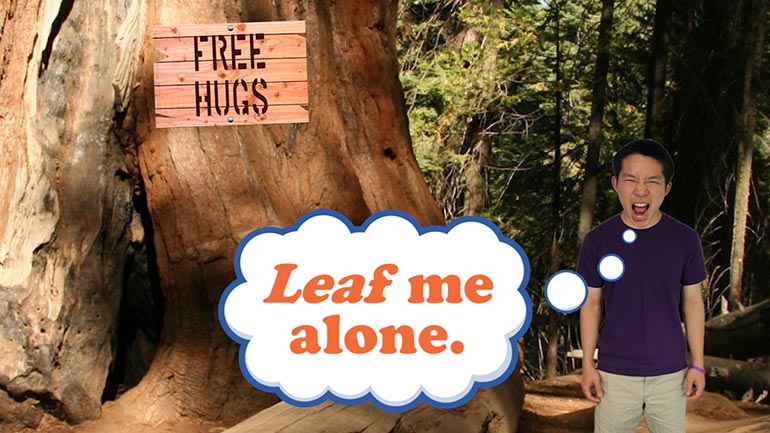ShmoopTube
Where Monty Python meets your 10th grade teacher.
Search Thousands of Shmoop Videos
Social Studies 4: Landform Creation and Changes 77 Views
Share It!
Description:
Mountains can be formed by plates colliding and stacking on top of each other. And no, we're not just referring to the "mountains" your mom yelled at you about after you forgot to do the dishes. We'll learn all about that and more in today's video on landform creation. About real mountains, that is, not the dishes.
Transcript
- 00:05
[Dino and Coop singing]
- 00:13
A giant mountain pops out of nowhere. [Mountains appear on a beach]
- 00:16
Deep valleys and a river form moments later. [A river appears]
- 00:19
An impressive castle appears out of thin air. [Big sand castle appears]
- 00:21
…Only to be devastated by a giant tsunami. [Everything is washed away by a big wave]
Full Transcript
- 00:24
Just your typical day at the beach. [Boy looks shocked]
- 00:26
But… unlike your beach-day sandcastles, sand-mountains, sand-valleys
- 00:30
and sand-whatever-else-you-can-imagine… [Sand sculpture of lions]
- 00:32
…real landforms take a heck of a lot longer than five minutes to build…and destroy. [A canyon is formed as two pieces of land pull apart]
- 00:36
In reality, landforms take years…like hundreds, thousands or even millions of ‘em… to [Coop pointing at a blackboard]
- 00:42
form and change over time.
- 00:43
There are many factors at play, including:
- 00:46
Plate movement, water, erosion and weathering. [Dino pointing at a blackboard]
- 00:49
Some of the same stuff that changes a person’s face in forty years from this…to this. [Young woman's face changes to and old woman]
- 00:54
So… how do each of these factors work?
- 00:56
Plate movement refers to the layers underneath the Earth – tectonic plates – that move [Diagram showing how plate movement works]
- 01:00
gradually over millions and millions of years, eventually shifting on top of one another. Totally an
- 01:06
invasion of personal space. [Tectonic plates on a bunk bed]
- 01:07
Mountains are formed when these plates collide and one gets pushed upward. [A plate rising up on another]
- 01:12
Mount Everest was formed when two plates collided over 60 million years ago… and it's still
- 01:17
growing to this day. There’s a mountain who eats his Wheaties. [Picture of Everest with a box of Wheaties]
- 01:20
However… it only grows about a quarter of an inch each year or so…if you were planning
- 01:24
on filming a time-lapse video of the mountain in action, have fun. [Old guy trying to film a time-lapse]
- 01:27
Water is also a big cause of landform creation, and unlike the slow growth of mountains, can
- 01:32
actually be observed over short periods of time. [Coop pointing at a blackboard]
- 01:35
Moving water, like rivers and oceans, can sculpt the landscape on a daily basis. [A TV showing a river]
- 01:39
Rivers can set a path and create riverbanks, while oceans can change the way beaches look
- 01:43
as the waves flow in and out. [Waves breaking on a beach]
- 01:45
And water is also involved in a more long-term landforming process, too: erosion.
- 01:50
Erosion refers to the movement of materials, like sediment and rock, from one location [Dino pointing at a blackboard]
- 01:55
to another. Water and wind can both cause erosion, and over long periods of time, can [Sand blowing in the wind]
- 01:59
leave a big impact on the way the earth looks.
- 02:02
A perfect example of erosion is the Grand Canyon, where the Colorado River has slowly
- 02:06
picked up and moved the rock surface over millions of years, leaving a deep and breathtaking canyon. [Video of the Grand Canyon]
- 02:13
It can also take your breath away for good if you get too close to the edge, so uh…be careful. [Man falls off the edge trying to take a cool picture]
- 02:17
Weathering is similar to erosion but with one distinct difference: while erosion is
- 02:21
all about moving rock and materials from one place to another, weathering specifically [Rock goes by in the ocean]
- 02:25
describes the breaking down of earth's materials.
- 02:28
In other words, weather is all about destruction. Which is why we’re so terrified by meteorologists. [Guy giving the weather report on TV with a skull and crossbones on the forecast]
- 02:34
Weather can be done by water or wind, and sometimes even both. One example would be
- 02:38
cliffs beside a beach.
- 02:40
Due to both the constant wind and the splashing of the waves, the rock formations that make [Waves breaking on the rocks]
- 02:44
up this cliff can change appearance over time…
- 02:46
…sometimes resulting in pretty cool effects.
- 02:48
But whether it's by moving plates, water, erosion or weather, landforms rarely appear overnight. [Dino pointing at a blackboard]
- 02:54
If you suddenly notice a mountain in your back yard, you should probably call the local authorities.
- 02:58
It’ll probably be arrested for breaking a law of nature… [Shmoop police telling a mountain to take a hike]
Up Next
Sticks and stones, right? Well...only sometimes. It's a good idea to make sure your words aren't going to hurt others. Let's look at some ways to d...
Related Videos
Learn to debate like a champ. It's way better than debating like a chimp. That just takes mudslinging to a whole new level.
Today we'll learn about biographies and autobiographies. And no, the second one has nothing to do with the lives of cars.
In this lesson we'll subject you to some verbs and predicates. Each one is a necessary part of a complete breakfas—er...sentence.
Choosing words carefully is important. You may end up vexing the assemblage of citizens you're conversing with...or you might even just plain bore...




